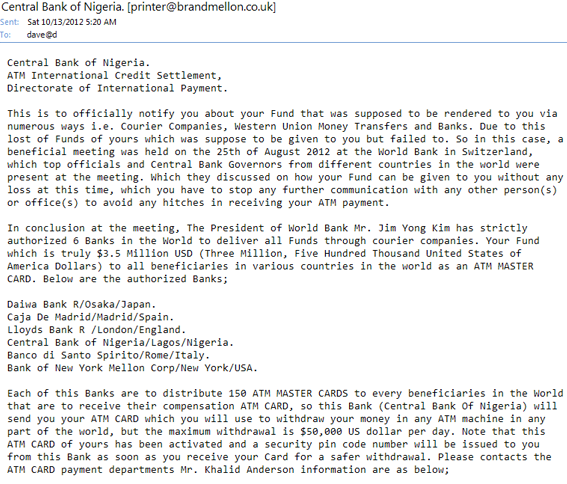 You may have received such emails, with dodgy English, suspicious email ids, and even dodgier propositions. Most of the people (in fact, not most, but all of you who are reading this) recognise this as a scam, and put such emails into their spam/junk folders. Then, you forget about them.
You may have received such emails, with dodgy English, suspicious email ids, and even dodgier propositions. Most of the people (in fact, not most, but all of you who are reading this) recognise this as a scam, and put such emails into their spam/junk folders. Then, you forget about them.However, have you wondered why these work? Why would any generally sane, even minimally educated, and nominally thinking person believe such preposterous offers? Why would anyone at all take this up and reply to the scammer? And, it follows, why would the scammers then continue to use this route if no one fell for it and it didn’t work?
If you have thought about it, I am sure you would have come to the conclusion that the scammers persist with this method because obviously, it pays off enough times for them to turn a profit.
Much research has gone into this, and I do not want to regurgitate the same. But suffice to say, there are three reasons why this works:
- There is an in-built success rate in numbers. During the days I used to sell door-to-door, my team lead would throw a statistic at a huddle. He’d say that if you were to knock on 100 doors, and assuming each door was opened, and if you said something like, “You don’t need insurance, right?”, chances are 5 of them will call you in and tell you they actually want to buy insurance! Now, whether this is a true scientifically accurate statistic or he was just making it up is immaterial, because when I sold stuff, I realised that it is literally a number game. The actual percentage of success varies from business to business, and from time to time, and so on, but there is no doubt that there is a simple correlation between how many doors you knock and how much you sell. So, a 419 scammer would assume (rightly, it would seem) that if they send 100,000 emails, there’s a hit rate, however low, that is in whole numbers.
- Confirmation bias, which is a tendency to search for, interpret, favour, and recall information in a way that confirms one’s preexisting beliefs or hypotheses. A human need to search for validation is what drives many scams like astrology, tarot, fortune-telling and of course, the 419 scam. A recipient of such a mail really wants to believe that they are finally, after all these years of living a normal, boring life (like almost every human on this planet), getting what they richly deserve, which is a break. When they receive such emails, they do not question why it could be a mistake, or a scam, or a prank. They actively seek out reasons, signs, signals, and words that convince them that it is real, that it is indeed happening, and that they are finally getting the break they have so longed for.
- Human frailty, which is the most obvious factor actually. Emotions like greed are primarily responsible. Greed clouds the intellect and contorts morals, and given that most such emails expect you to break some laws by impersonating someone, by lying to the bank, my swearing on oath things you know to be lies, and so on, the recipient is hardly in a position or readily willing to discuss this (and the subsequent failure and loss of money) with anyone else, least of all, the law enforcement people, leave alone friends and people who are smarter than them. In fact, even once they realise that they have been scammed, most victims are known to go to great lengths to continue to defend their actions and even go for years claiming that they did nothing wrong, and their lottery money might still be on its way.
But that still does not explain why these scamsters continue to use such badly written English. Why the spelling mistakes and the punctuation errors? Why the grammatical howlers and the random capitalisation? Why are such mails not written in a more polished language? Also, why are the scams so blatant and so clearly fraudulent? And why the tall, clearly unbelievable, claims? I mean, most people might actually believe a mail that says they have just won a toaster or even a car in some believable raffle, or maybe a small amount like $500 in a lottery. They’d be easy to con into wiring say $5 into a random foreign account to claim their gift. You’d get much better numbers and much lesser people who’d complain of being robbed of a few bucks online.
So, why talk of millions and hundreds of millions of dollars? Why make up incredible stories of royal demises and untreatable illnesses, dying widows of deposed dictators and unscrupulous bankers in large, reputed banks? Why be so flagrantly and transparently “scammy” that to any person with moderate intelligence, this mail wouldn’t pass muster to even read to the end, leave alone act on? Have you wondered if it is because the people behind the scams are either stupid, or do not use English as their first language, or that perhaps there is no feedback loop where lessons from previous attempts to scam random strangers on the internet are put into practice in the next round of scam emails? Do you think the obvious inaccuracies, transparent inconsistencies, and glaring syntax errors are a result of a lack of knowledge or do you think there is some intelligent strategy behind the specific language used in these emails?
Here’s the thing about the bad language and barefacedness of these emails: It is all a deliberate ploy to filter out everyone but the stupidest, the most naive, and the most gullible of the recipients, who by just responding to such a badly written communication, signal to the scammer that they are good targets and more likely (than those that did not respond) to believe their future correspondence to send them money. In effect, it is a filter that victims use to identify themselves as gullible to the scamster without any further due diligence or scoping. Like a self-qualification system. And, as we all know, it works like magic!
Now, when I saw fake news for the first time, I remember thinking to myself, “Who’d believe this crap? It looks transparently fake. The image is clearly photoshopped, the claims the text makes are so outrageously incredible that the people who are circulating this news must think of me as some special kind of stupid.”
Obviously, I did not realise that I was never the intended audience for such news. Nor were most others who were on my friend list. In fact, by discarding and not challenging it, we actually did the fake news-makers a favour. It passed unnoticed by exactly those people who could have debunked it.
And then, it reached the gullible.
As you’ll notice, barring rare exceptions, the exact same techniques used by the 419 scammers are used by fake news-makers. The grammar is off, the spelling is horrendous, the design seems an afterthought, the images are manipulated badly, and the claims are laughable. But what that does is:
- Be passed over by smarter people who could turn around and challenge it, were it written better and had a more polished appearance to at least seem like an argument worth having.
- Act as a natural filter to find the most gullible.
People who fall for fake news do so for more or less the same reasons as those who fall for the 419 scams:
- Sheer numbers: The generation of fake news in organised factories run by professionally trained managers paid well by their parent organisations is so large in volume and vast in numbers that it is inevitable that some of it will pass unnoticed and reach the intended audience.
- Confirmation bias: While smarter people are more interested and curious to explore the world with an open mind (and eyes), Mr Joe Regular is looking for validation for views already very dearly and fervently held. If the fake news item creates even a tinge of support for his opinions, he’s sold. He now no longer seeks out explanations for the glaring holes, but satisfies himself with the speck of dubious data or image that confirms his point of view.
- Human frailty: Tribal affiliations, like caste, language, region, skin colour, width of eyes, costume, food preferences, and religion play a large role in creating envy, hate, xenophobia, and prejudice for the “other.” Such emotions and cultural and social conditioning since childhood combine with the need to find reasons to justify these (emotions) when faced with a sliver of information, however dodgy-looking and from however an untrustworthy source, to form a firm opinion that now has the backup of “data” from the fake news article.
In summary: Fake news and the 419 Nigerian mail scam are very similar, in the reasons why they work.
Now, to this flammable mix, add social media, ease of communication, and a friendly administration, and you have the spark needed to trigger the explosion that ends in hate, fear, and broken bridges at best, and murder and crime at worst. Interestingly, when the repercussions of such fake news (hate crimes, mainly) are broadcast as real news, such publicity actually spurs the cycle, and creates the next wave of fake news items. What this does for the social fabric is not something we can visualise today, but most historians in the 22nd century would be able to see clearly, hindsight being what it is.
P.S: Hat-tip to Karthik Natarajan for the epiphany.



















